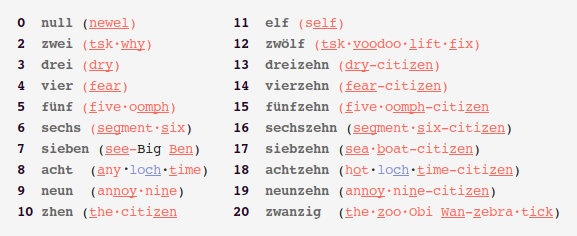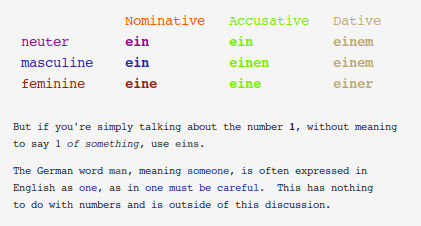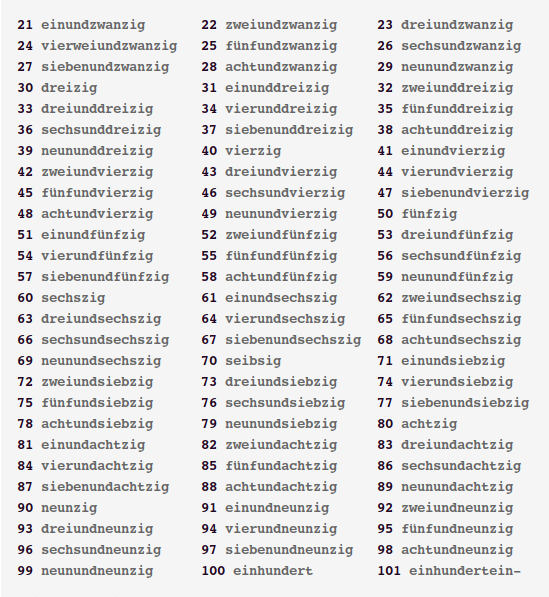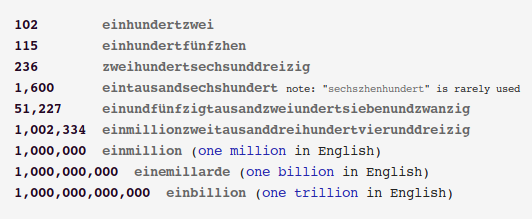When I first started learning this, the only German numbers I knew were 1 through 4: eins (eye·one·list), zwei (tsk·why), drei (dry), vier (fear), or (one, two, three, four). I remembered them as eins, zwei, drei, vier; eins, zwei, drei, vier; eins, zwei, drei, vier; from watching too many old war movies and TV shows such as Hogan’s Heroes I suppose.
Numbers up to 20
Anyway, here are the German numbers from 0 to 20:

Notes:
◆ As in English, there are unique words for the numbers up to 12. After that, most number words are built by combining other words.
◆ The suffix -zehn corresponds to the English suffix -teen.
◆ The suffix -zig corresponds to the English suffix -ty. (It can also be pronounced –zipper·fish depending on which German dialect you are using.)
◆ Instead of siebenzhen, the number 17 is shortened to seibzhen (sea·boat-citizen).
Wait a minute. What happened to the number one?
The number one is a special case. Unlike all the other numbers, it must match in gender and case to whatever it is you have one of. Then it takes the same endings as articles. In fact, this word is ein-, which is the same word as the word for a/an. So how do you tell the difference? When you see ein- in a sentence, how do you know if it’s one or a/an? The answer is you can’t, but it doesn’t make any difference anyway, because one of something is the same as a something, isn’t it? So when you come across the word ein-, you have your choice to think of it as one of something or a something, and don’t start worrying about which it really is.
Anyway, here is the table for the various kinds of one:

The numbers 21 through 99
With the numbers 21 through 99 a funny thing happens. The units digit comes first, followed by the tens digit, an und is put between, and the whole thing is pushed together into a single word. This is often called the “sing a song of sixpence method” because, as in the nursery rhyme of that name, 24 comes out four and twenty rather than twenty and four or twenty four. It takes a bit of getting used to, but that’s the way it’s done.
The table for the numbers 21 to 101 is given here:

Notes:
◆ Instead of siebenzig, the number 70 is shortened to seibzig (Sea·boat-zebra·tick).
◆ Because 101 ends in ein-, it takes an ending just like the number 1.
More numbers
Hundreds are in the form of a single-digit number, such as vier, followed by hundert. Thousands are a single-digit number followed by tausend, further followed, if necessary, by additional digits past the thousands digit.
Millions are in the form of a single-digit number, the word Million (milling-yogurt-den) if just one million, the word Millionen (milling-yogurt-ten·men) if two million or more, followed hundreds, units, and tens as needed.
The number 1,000,000,000 is a Milliarde. The number 1,000,000,000,000 is a Billion. Note that a billion in English and a Billion in German are not the same thing; use caution when working with large numbers.
Some examples:

Ordinal numbers
Ordinal numbers are generated by taking the cardinal (basic) number and adding -te- to it, unless it already ends in a -t, in which case, just add -e- to it — then add an adjective ending. However, the ordinals first and third are special cases: first is erst- (sometimes zuerst), and third is dritte-. Examples: Take the 2nd card is Nehmen Sie die zweite Karte. Go to the 3rd floor is Geh zu den dritten Stock
Days of the month are normally in ordinal form. For example, Christmas is the 25th of December is Weihnachten ist der fünfundzwanzigste Dezember.
Fractions
Fractions are a cardinal numerator followed by a ordinal denominator. The denominator always ends in -el, with the exception of halb- (half). For thirds, use Drittel. Sometimes, a numerator of 1 is left out. A few examples:
I ate two-thirds of the pie. Ich habe zwei Drittel des Kuchens gegessen. I watched half the show. Ich habe die halbe Show gesehen.
Decimals
German is a “decimal point is comma” language. So, in digits, what would be 1,002,307.5 in English becomes 1.002.307,5 in German.
Look for Jennie’s German Language Classroom for English Speakers on a Wednesday near the end of the month.
Copyright © 2021 by Jennifer Freeman. In particular, permission is not granted to assemble the parts of this series together and distribute them. You may of course post links to the individual posts.
